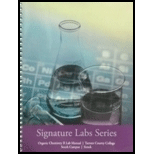
ORGANIC CHEMISTRY II LAB MANUAL>CUSTOM<
9th Edition
ISBN: 9780534261641
Author: SIMEK
Publisher: Cengage Learning
expand_more
expand_more
format_list_bulleted
Concept explainers
Textbook Question
Chapter 22, Problem 22.66SP
- a. Rank these compounds in order of increasing acid strength.

- b. Rank these compounds in order of increasing enol content. In each case, draw the most stable enol.

Expert Solution & Answer
Want to see the full answer?
Check out a sample textbook solution
Students have asked these similar questions
Reason whether it is possible to determine changes in the Galvani potential difference at the metal-solution interface.
Obtain the standard potential at 25°C of the Cu* I Cu | Pt electrode
from the standard potentials E°
Cu²+/Cu
= 0.341 V and E
Cu²+ /Cu+
= 0.153 V.
In electrochemistry, briefly describe the Galvani potential, the Volta potential, and the surface potential. Differentiate between them.
Chapter 22 Solutions
ORGANIC CHEMISTRY II LAB MANUAL>CUSTOM<
Ch. 22.2A - Prob. 22.2PCh. 22.4 - Without looking back, propose a mechanism for the...Ch. 22.4 - Prob. 22.8PCh. 22.4 - Prob. 22.9PCh. 22.5A - Prob. 22.10PCh. 22.5A - Prob. 22.11PCh. 22.5B - Prob. 22.12PCh. 22.5B - Predict the products of the following reactions....Ch. 22.5B - Which compounds will give positive iodoform tests?...Ch. 22.5C - Propose a mechanism for the acid-catalyzed...
Ch. 22.5C - Acid-catalyzed halogenation is synthetically...Ch. 22.6 - Show the products of the reactions of these...Ch. 22.7A - Prob. 22.18PCh. 22.7A - Prob. 22.19PCh. 22.7A - Prob. 22.20PCh. 22.7B - Prob. 22.21PCh. 22.8 - Prob. 22.22PCh. 22.8 - Prob. 22.24PCh. 22.9 - Prob. 22.25PCh. 22.9 - Prob. 22.26PCh. 22.9 - Prob. 22.27PCh. 22.9 - Prob. 22.28PCh. 22.9 - Prob. 22.29PCh. 22.10 - When cyclodecane-1,6-dione is treated with sodium...Ch. 22.11 - Prob. 22.32PCh. 22.11 - Prob. 22.33PCh. 22.12 - Prob. 22.34PCh. 22.12 - Prob. 22.35PCh. 22.12 - Prob. 22.36PCh. 22.12 - Prob. 22.37PCh. 22.12 - Show what esters would undergo Claisen...Ch. 22.13 - Prob. 22.39PCh. 22.13 - Prob. 22.40PCh. 22.14 - Prob. 22.41PCh. 22.14 - Prob. 22.42PCh. 22.14 - Show how crossed Claisen condensations could be...Ch. 22.14 - Prob. 22.44PCh. 22.14 - Prob. 22.45PCh. 22.15 - Prob. 22.46PCh. 22.16 - Prob. 22.47PCh. 22.16 - Prob. 22.48PCh. 22.17 - Prob. 22.49PCh. 22.17 - Prob. 22.50PCh. 22.17 - Prob. 22.51PCh. 22.18 - Prob. 22.52PCh. 22.18 - Prob. 22.53PCh. 22.18 - Prob. 22.54PCh. 22.18 - Prob. 22.55PCh. 22.18 - Prob. 22.56PCh. 22.19 - Prob. 22.57PCh. 22.19 - Prob. 22.58PCh. 22.19 - Prob. 22.59PCh. 22 - Prob. 22.60SPCh. 22 - 1. Rank the following compounds in order of...Ch. 22 - Prob. 22.62SPCh. 22 - Prob. 22.63SPCh. 22 - Prob. 22.64SPCh. 22 - Pentane-2,4-dione (acetylacetone) exists as a...Ch. 22 - a. Rank these compounds in order of increasing...Ch. 22 - Prob. 22.67SPCh. 22 - Prob. 22.68SPCh. 22 - 22-69 Predict the products of the following...Ch. 22 - Predict the products of these reaction sequences.Ch. 22 - Show how you would accomplish the following...Ch. 22 - Prob. 22.72SPCh. 22 - Prob. 22.73SPCh. 22 - Prob. 22.74SPCh. 22 - The Knoevenagel condensation is a special case of...Ch. 22 - Prob. 22.76SPCh. 22 - Propose mechanisms for the following reactions.Ch. 22 - Prob. 22.78SPCh. 22 - Show how you would accomplish the following...Ch. 22 - Prob. 22.80SPCh. 22 - Propose a mechanism for the following reaction....Ch. 22 - Prob. 22.83SPCh. 22 - Prob. 22.84SPCh. 22 - Prob. 22.85SP
Knowledge Booster
Learn more about
Need a deep-dive on the concept behind this application? Look no further. Learn more about this topic, chemistry and related others by exploring similar questions and additional content below.Similar questions
- What substances can neutralize, complex or adsorb and absorb both HF and CF carbonyl fluoride and hydrogen fluoride and intermediate formation of thermal decomposition of fluorinated inorganic compounds either due to hydrolysis and hygroscopic reactions. What is the known chemistry of these reactions and mechanisms.arrow_forwardBriefly differentiate between chemical potential and electrochemical potential.arrow_forwardAccording to open access forums ionic antimony Sb (111) can be reduced to elemental Sb (0) in solution and in macromolecules like condensation polymers polyethylene terephthalate (PET) causing greying of the polymer matrix. It has been connected to thermal degradation of the polymer during processing to the formation of thermally unstable EG ethyleen glycol that forms at various temperatures formic acid, formaldehyde, acetaldehyde and much more depending on temperature. I need to know what organics are more powerful reducing agents and at what concentration (relative) to each organic will initiate this reduction. Furthermore, is the pH dependant ? Are other trace elements in the plastic also a cause of concern e.g. aluminum from aluminum chloride (lewis acid). Therefore, the ultimate solution should include a means to inhibit reduction of ionic antimony and will the same solution comply with cobalt impurities from ionic cobalt? Some PET have combinations of catalyst and their residues…arrow_forward
- From a pH standpoint is the reduction of ionic Antimony Sb (111) to elemental Sb (0) occur more readily by acidic species acting as reducing agents or basic substances? I want to inhibit this reduction of ionic to elemental. Suggestions and directions!arrow_forwardObtain the standard potential at 25°C of the Cu* I Cu | Pt electrode from the standard potentials E° Cu²+/Cu = 0.341 V and E Cu²+ /Cu+ = 0.153 V.arrow_forwardState two variables on which the transport number in electrochemistry depends.arrow_forward
arrow_back_ios
SEE MORE QUESTIONS
arrow_forward_ios
Recommended textbooks for you
 Organic Chemistry: A Guided InquiryChemistryISBN:9780618974122Author:Andrei StraumanisPublisher:Cengage Learning
Organic Chemistry: A Guided InquiryChemistryISBN:9780618974122Author:Andrei StraumanisPublisher:Cengage Learning

Organic Chemistry: A Guided Inquiry
Chemistry
ISBN:9780618974122
Author:Andrei Straumanis
Publisher:Cengage Learning
Nomenclature: Crash Course Chemistry #44; Author: CrashCourse;https://www.youtube.com/watch?v=U7wavimfNFE;License: Standard YouTube License, CC-BY